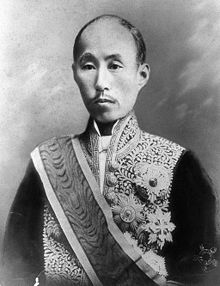Sanjō Sanetomi
Sanjō Sanetomi ( Japanese 三条 実 美 ; * March 13, 1837 ( Japanese calendar : Tempō 8/2/7) in Kyōto ; † February 18, 1891 ) was a Japanese court nobleman ( kuge ) who started the Meiji Restoration in 1863 and held a variety of government posts in the pre-constitutional period.
Youth and family
Sanjō Sanetomi was born as the second son of Sanjō Sanekazu . The father held the high office of Udaijin ("Chancellor on the right") until his death, when he was a victim of the Ansei Purges under the leadership of Ii Naosuke in 1859 . The mother was a daughter of Yamanouchi Toyokazu , the daimyo of Tosa . His youth name was Yoshimaro . The Sanjō family came directly from the Hokke house of the Fujiwara , hence the name Fujiwara no Saneyoshi . His teacher was Tanemori Yoshiomi . Due to his noble birth, he was awarded the following lower 5th court rank as early as 1849 . At the end of 1855, at the age of 18, he was already in the real fourth lower rank, at a time when the opening of trading places forced by Commodore Perry triggered a deep political crisis.
Until 1867
Sanjō was initially part of the Sonnō-jōi faction ("Adore the emperor! - Away with the barbarians!"). In 1862 he was Chūnagon ( hereinafter 3rd court rank). In 1863 he belonged to the Mikado's embassy to the court of the shogun , led by Anegakōji Kintomi , which asked him to meet at the imperial court in Kyoto and to take precautions to expel the foreigners by spring 1864.
When the more moderate Aizu and Satsuma politicians gained the upper hand in the August 18, 1863 coup , he was one of the seven courtiers whose removal was requested. Sanjō fled to Chōshū under the protection of the Daimyō Mōri . From 1864 he stayed in Dazaifu .
After 1867
After Tokugawa Keiki's resignation , he returned to Kyoto. In the imperial government formed at the end of 1867, he served in a double function as Fukusōsai (Vice President) and General Secretary. From the latter post he resigned on January 20, 1868, whereupon he was transferred to the position of Dainagon on February 20, 1868 . He was also governor for the eight Kantō provinces. On April 24th he was appointed commander of the left palace guard.
With the restructuring of the government in April and May 1868, his posts were abolished. Within the new structure, he became Udaijin . This position was held from June 11, 1868 to August 15, 1871. He was then appointed Grand Chancellor ( Daijō Daijin ), the last incumbent until this position was abolished with the introduction of the cabinet system in late 1885.
On April 11, 1882 he was awarded the "Ribbon for the Grand Cross of the Chrysanthemum Order ". Under the newly created nobility classification ( kazoku ) he was prince on July 7, 1884 ( kōshaku ).
After the introduction of the cabinet system, he became the keeper of the Lord Seal ( naidaijin ) on December 22, 1885 .
When Kuroda Kiyotaka and his cabinet resigned, he served from October 25 to December 24, 1889 as executive prime minister .
In February 1890 he took his seat in the manor house , which was automatically due to him as kōshaku .
On February 18, 1891, he was awarded the real first court rank - now purely ceremonial. Sanjō died at the age of 55 on the same day. On the 25th he received a state funeral. His grave is in Gokokuji, Tokyo .
source
- Kodansha Encyclopedia of Japan Vol. VII
literature
- Kunaishō Zusho-ryō: Sanjō Sanetomi kō nempu . Tōkyō 1901 (new edition from 1969); (Japanese biography)
Web links
- ↑ Dates here according to the Japanese calendar.
- ↑ after: Gritzner, Maximilian; Handbook of Knights and Orders of Merit ...; Leipzig 1893; Reprint Graz 1962, p. 180ff.
| personal data | |
|---|---|
| SURNAME | Sanjō, Sanetomi |
| ALTERNATIVE NAMES | 三条 実 美 (Japanese); Fujiwara no Saneyoshi; Sanjō, Yoshimaro (youth name) |
| BRIEF DESCRIPTION | Japanese nobleman, politician and interim premier of the early Meiji period |
| DATE OF BIRTH | March 13, 1837 |
| PLACE OF BIRTH | Kyoto |
| DATE OF DEATH | February 18, 1891 |
